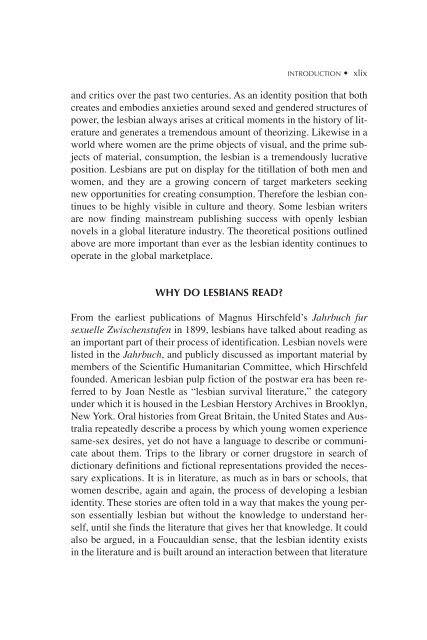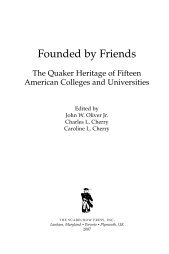Historical Dictionary of Lesbian Literature - Scarecrow Press
Historical Dictionary of Lesbian Literature - Scarecrow Press
Historical Dictionary of Lesbian Literature - Scarecrow Press
Create successful ePaper yourself
Turn your PDF publications into a flip-book with our unique Google optimized e-Paper software.
and critics over the past two centuries. As an identity position that both<br />
creates and embodies anxieties around sexed and gendered structures <strong>of</strong><br />
power, the lesbian always arises at critical moments in the history <strong>of</strong> literature<br />
and generates a tremendous amount <strong>of</strong> theorizing. Likewise in a<br />
world where women are the prime objects <strong>of</strong> visual, and the prime subjects<br />
<strong>of</strong> material, consumption, the lesbian is a tremendously lucrative<br />
position. <strong>Lesbian</strong>s are put on display for the titillation <strong>of</strong> both men and<br />
women, and they are a growing concern <strong>of</strong> target marketers seeking<br />
new opportunities for creating consumption. Therefore the lesbian continues<br />
to be highly visible in culture and theory. Some lesbian writers<br />
are now finding mainstream publishing success with openly lesbian<br />
novels in a global literature industry. The theoretical positions outlined<br />
above are more important than ever as the lesbian identity continues to<br />
operate in the global marketplace.<br />
WHY DO LESBIANS READ?<br />
INTRODUCTION • xlix<br />
From the earliest publications <strong>of</strong> Magnus Hirschfeld’s Jahrbuch fur<br />
sexuelle Zwischenstufen in 1899, lesbians have talked about reading as<br />
an important part <strong>of</strong> their process <strong>of</strong> identification. <strong>Lesbian</strong> novels were<br />
listed in the Jahrbuch, and publicly discussed as important material by<br />
members <strong>of</strong> the Scientific Humanitarian Committee, which Hirschfeld<br />
founded. American lesbian pulp fiction <strong>of</strong> the postwar era has been referred<br />
to by Joan Nestle as “lesbian survival literature,” the category<br />
under which it is housed in the <strong>Lesbian</strong> Herstory Archives in Brooklyn,<br />
New York. Oral histories from Great Britain, the United States and Australia<br />
repeatedly describe a process by which young women experience<br />
same-sex desires, yet do not have a language to describe or communicate<br />
about them. Trips to the library or corner drugstore in search <strong>of</strong><br />
dictionary definitions and fictional representations provided the necessary<br />
explications. It is in literature, as much as in bars or schools, that<br />
women describe, again and again, the process <strong>of</strong> developing a lesbian<br />
identity. These stories are <strong>of</strong>ten told in a way that makes the young person<br />
essentially lesbian but without the knowledge to understand herself,<br />
until she finds the literature that gives her that knowledge. It could<br />
also be argued, in a Foucauldian sense, that the lesbian identity exists<br />
in the literature and is built around an interaction between that literature
















